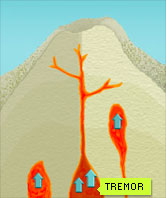
|
|
Tremor
A tremor is a long-period (LP) event, but one that lasts
longer than the typical LP event. In fact, a single tremor can
last anywhere from several minutes to months.
The frequency range of a tremor is the same as that with an LP
event: one half of a cycle to three cycles per second. The
signal shown here has a frequency of two cycles per second.
Like LP events, tremors can also be a good indicator of an
impending volcanic eruption.
|

The source of a tremor can and often is the same crack or channel
that produces LP events. The difference is that, with a tremor, the
waves of pressure traveling through the magma get a little extra
push every so often. This push can be pressure changes coming
through magma channels from below. Because the waves creating the
tremor travel at the cracks' resonant frequency (see LP section),
the signal can appear as a continuous wave moving at a single
frequency.
Volcano-Tectonic Event
| Long Period Event |
Tremor |
Hybrid
|
|


